CNetX Flash Format 2.61Chris Tilley | Edit-in-Chief It's a full on, hard-hitting world that we live in. It's easy to under state just how much rough and tumble my trusty Handheld PC's can get in the course of a week. With that rough and tumble it's perhaps all too easy to become complacent over just how much of it computer hardware can take. If you're anything like me, you wont take too many chances with the data you carry around with you. It comes with the territory that invariably purchasing a Handheld means obtaining an external storage card of some sort - from somewhere. So, you keep your H/PC databases synced every day with Outlook on your host, and jubilantly install all your applications into external storage. Saving all your data along with it. Feeling safe? Yes? Well perhaps you shouldn't be. Now before you all run for your clamshells, don't worry. I'm not pre-ordaining a CF Armageddon. But what perhaps the average user doesn't realise is the actual life expectancy and reliability of any given solid-state (CF, SD, MMC, Memory Stick) storage device. They are actually fairly low. Depending on the technology the life of a solid-state device can be anything from 100,000 read / write actions down to 10,000. With this in mind, it's clear that keeping your storage cards in tip-top condition should be of paramount importance, as well as keeping an eye out for those tell-tale signs that can rapidly lead to data loss. CNetX have just the answer. Flash Format. At which point the last thing you want to be thinking about is "do I want to format away all my precious data". Now this is where Flash Format simply comes into it's own. For not only is it capable of correctly formatting your storage cards. (in the way that you want them to be) It is also an integrity checker. Precisely just what most users really need when CE decides it can no longer be friends with your data. CNetX are not the highest profile developer in the Handheld PC world, which is a shame because they really have thought about their products from a users stand point. When you come to download the application you are presented with a wizard asking you to specify your device type, as well as clearly outlining what devices and processors are supported. 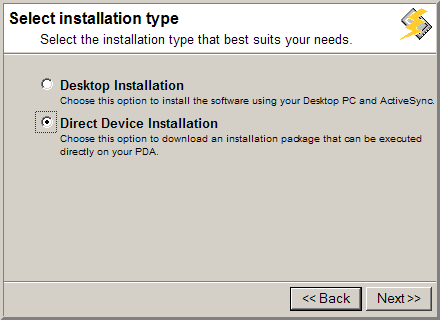
Once selected you are prompted to choose whether you wish to download the host side installer application, or download a version specifically for the device. Once installed, you may be puzzled by the absence of the application on the Start Menu. CNetX have chosen to make Flash Format available through the Control Panel rather than as a standard program. Once you know where it is, this isn't a problem.
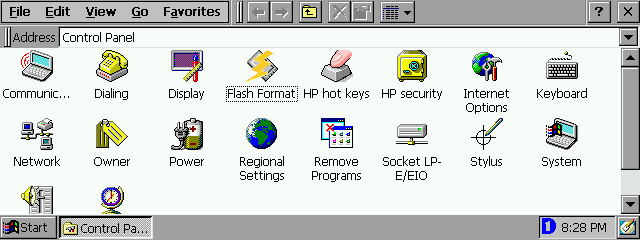
Double tapping the icon prompts Flash Format to search for storage devices 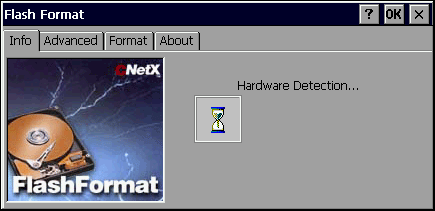
Once loaded the 'Info' tab will be displayed, listing the details of your primary storage device. (the one represented in Windows CE Explorer as "Storage Card") Information displayed here is self explanatory. The "Samsung-Rev 1.15-A558" is the manufacturer id of the storage card itself and will vary between hardware. 
Basic information on the card is provided as one would expect. The only entry listed here that may cause some confusion is what CNetX term "Slack Space". (I call it cluster waste). Without getting overly technical, this is a syndrome common to all storage devices where by the data storage is divided up into small clusters. Only 1 file can share 1 cluster. So if you have a 64KB cluster size on your storage device, and a 96KB file. One full 64KB cluster will be used and only 32KB of the second. Leaving 32KB empty and unusable until the file is deleted, moved or modified. 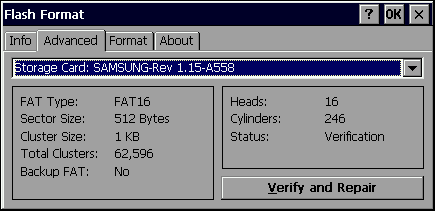
Moving along to the 'Advanced' tab, the information becomes more technically orientated. The data provides some statistics on your current configuration. The specific details of which are beyond the scope of this review. Suffice it to say that if you have a need to know what they are, the info is exceptionally useful as it cannot be found elsewhere in Windows CE. When CNetX first sent us the review license I inserted the CF card that has lived in my hp 340LX / Digital camera, unchecked since at least 1998. 
It is important to note that data recovery in this style is exceptionally difficult. While Flash Format did an excellent job at fixing errors. Some of the recovered data was restored as a CHK file. This means that the core information was recovered from the file. However Flash Format could not ascertain what the actual file name originally was. This is a situation found in ANY FAT recovery tool on ANY platform. 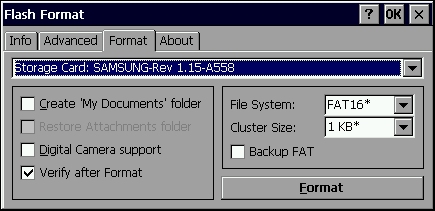
The 'Format' tab. Formatting is a sure way to alleviate most errors from a storage card. (Except for hardware errors caused by life expectancy constraints) The format process wipes the records of files from a storage device; attempts to reconstruct damaged data areas and forces the retesting of areas marked as "unusable". The options here afford you some commonly used features. Such as the Microsoft Standard "My Documents" folder being created after formatting. Verify after format it self-explanatory, however not enabled by default. I recommend that you enable this option when you format a card. It only adds a few seconds to the format time and is well worth the peace of mind. The 'File System' and 'Cluster Size' options are technical. Unless you specifically know what you are doing, and understand the consequences of changing these options you should leave these at their recommended values. (Marked with a *) Lastly, as mentioned above, CNetX have provided a possible solution to my 'unknown file' problem. This comes in the form of the 'Backup FAT' option. Flash Format does monitor for changes in state of any storage device. On each of the three main tabs a drop box has been on each, providing access to secondary or even additional storage adapters. The monitoring of this list is performed in real-time. So by ejecting a ATA Flash storage card from your device the entry will disappear and if applicable display a different storage device. Upon inserting a new card, again the list is updated and details on the new device are made available in milliseconds. Flash Format boasts an impressive array of supported storage devices including:
A good level of documentation is provided to aid the non-technical user around the program, however some of the technical terms used are not explained at the level of a non-technical user - or at all. This shouldn't pose a problem for most new users who likely wont wish to know anyway. CNetXs technical support team are helpful, knowledgeable and open about their product. We here at HPC:Factor like to test technical support as a matter of course during our reviews process. Our unassociated, technical request was picked up first thing Monday (European time) and we had a reply first thing Tuesday (UK time). Our request surrounding the use of Adaptec SCSI controllers was highly specialised, and while admitting they hadn't tested using a similar setup. Were helpful in explaining the checks undergone by Flash Format and Windows CE itself to ensure compatibility and what to look out for. CNetX Flash Format is available for $11.95 and a 14 day unrestricted trial is also available. The safeguards that Flash Format offers, combined with some very useful features that are sorely lacking in Windows CE itself make the price worth while. Even if you never need to use the data recovery system I would still recommend that users have Flash Format in their software library. ... and if you do have to use it. It'll have paid for itself 10 times over. System RequirementsWindows CE 2.11 and HPC2000 More information on CNetX Flash Format 2.61 can be found at Ratings
Further DiscussionLet us know what you thought of this review and the CNetX Flash Format 2.61 in the Community Forums! |
